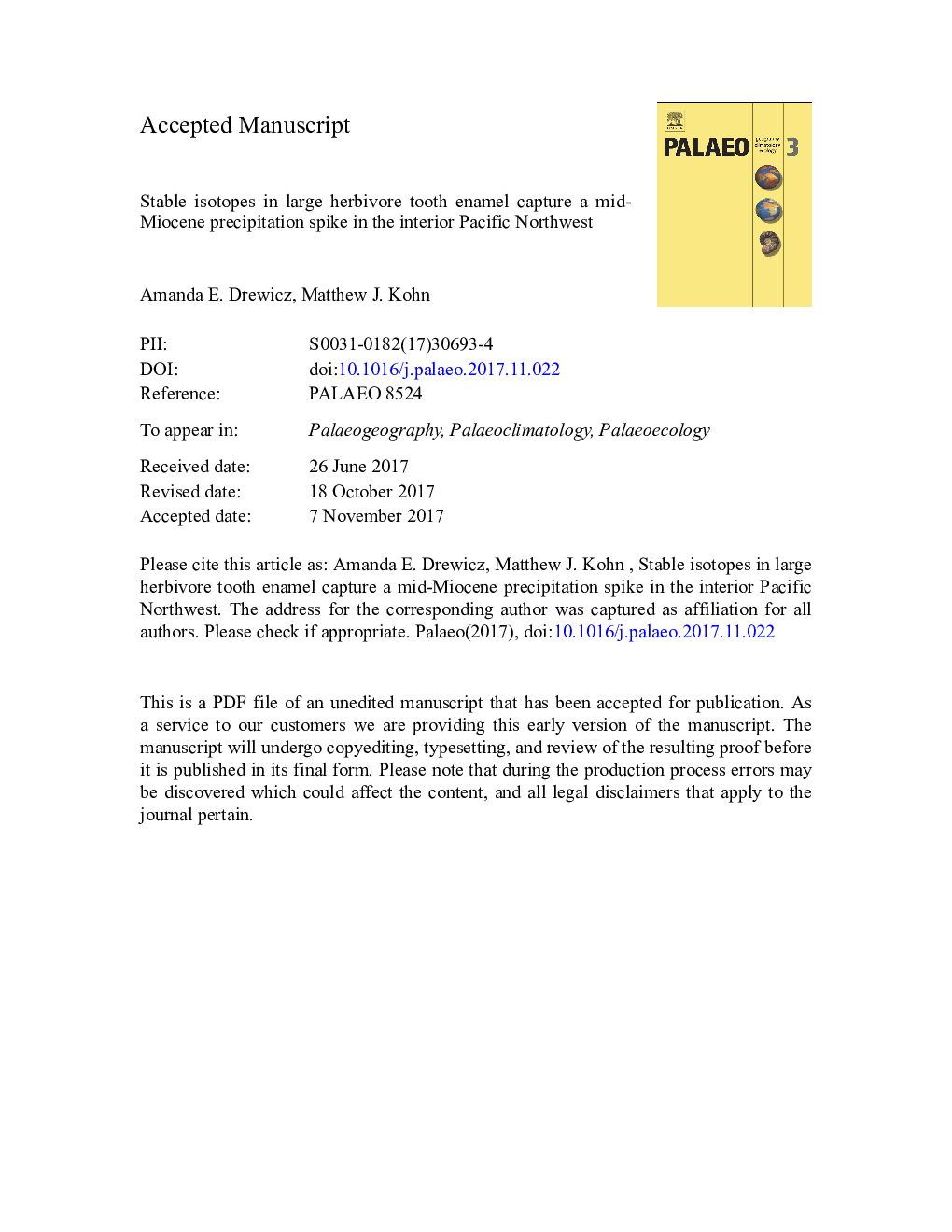| کد مقاله | کد نشریه | سال انتشار | مقاله انگلیسی | نسخه تمام متن |
|---|---|---|---|---|
| 8868311 | 1622097 | 2018 | 55 صفحه PDF | دانلود رایگان |
عنوان انگلیسی مقاله ISI
Stable isotopes in large herbivore tooth enamel capture a mid-Miocene precipitation spike in the interior Pacific Northwest
ترجمه فارسی عنوان
ایزوتوپهای پایدار در مینای دندانهای بزرگ گیاهخواری ضربات ناگهانی در اواسط میوزن در داخل منطقه اقیانوس آرام شمال غربی
دانلود مقاله + سفارش ترجمه
دانلود مقاله ISI انگلیسی
رایگان برای ایرانیان
کلمات کلیدی
پروکسی های پالئوس کلیت، ایزوتوپهای پایدار، متوسط بارندگی سالانه، اسبها، پستانداران بزرگ گیاهخوار،
موضوعات مرتبط
مهندسی و علوم پایه
علوم زمین و سیارات
فرآیندهای سطح زمین
چکیده انگلیسی
Stable carbon and oxygen isotopes of fossil ungulate tooth enamel were used to investigate the paleoclimate of the Pacific Northwest from the mid-Oligocene through Pleistocene, particularly targeting the mid-Miocene Climatic Optimum (MMCO). We specifically test whether precipitation, as inferred from tooth enamel δ13C values relative to the δ13C values of atmospheric CO2 (Î13C), increased with increasing partial pressure of atmospheric CO2 (pCO2). Analysis emphasized water-dependent equids, rhinos, and proboscideans, but several artiodactyls and Castor were also analyzed as available. Values of Î13C > + 19.5â° in the lower John Day (~ 27 and ~ 18 Ma) and Mascall (15-16 Ma) localities imply relatively high mean annual precipitation (MAP = ca. 550-800 mm/yr). Values of Î13C < + 18.5â° at ~ 18 Ma and at four levels between 15 and 3 Ma imply low MAP (â¤Â 250 mm/yr), similar to modern climate. High vs. low MAP generally correlates with high vs. low pCO2, implicating pCO2 as a probable driver of MAP in the Pacific Northwest. A climate oscillation model best explains data, such that warm-wet conditions during high pCO2 events alternated with cool-dry conditions during low pCO2 events on timescales of 100 kyr. Because of poor time constraints associated with many of the specimens, changes in pCO2 are mainly inferred from marine isotopic data, rather than direct comparison between terrestrial pCO2 reconstructions and MAP. High δ18O values in specimens from the John Day (+ 21.8 ± 1.0â°; VSMOW) and Mascall (+ 21.3 ± 0.8â°) Formations could reflect lower elevations for the upwind Cascade Range prior to ~ 7 Ma, or proximity to the coast compared to younger, more inland sites (δ18O = + 17.7 ± 0.9 to + 19.6 ± 1.1â°). Unusually high δ18O values of Dromomeryx sp. from Red Basin (+ 27.4 ± 0.2â°) probably reflect drought tolerance. General circulation models commonly reproduce temperature but underestimate precipitation during the MMCO in the Pacific Northwest, suggesting that refinements are needed to predict more accurately how western North American precipitation will respond to increases in pCO2 during the next century.
ناشر
Database: Elsevier - ScienceDirect (ساینس دایرکت)
Journal: Palaeogeography, Palaeoclimatology, Palaeoecology - Volume 495, 15 April 2018, Pages 1-12
Journal: Palaeogeography, Palaeoclimatology, Palaeoecology - Volume 495, 15 April 2018, Pages 1-12
نویسندگان
Amanda E. Drewicz, Matthew J. Kohn,
